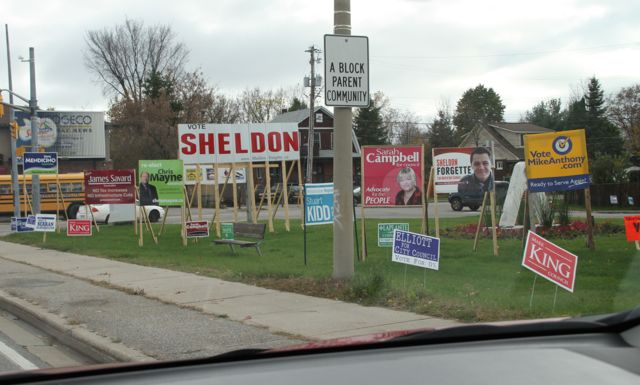
Election signs are everywhere on the corner of Lakeshore and Judge in North Bay. PHOTO BY CHRIS DAWSON.
When you drive down Main Street and over the overpass, you will see the green strip to your right dominated by election signs.
Denyse Lafrance-Horning has been a marketing professor at Nipissing University for seven years. She feels the multitude of election signage can be overwhelming.
“When you drive by a major intersection like the overpass, and you see like 180 signs, it just then becomes noise that we tend to weed out because we can’t possibly absorb all of these messages so we pick and choose which are the most interesting, entertaining or relevant. So I think for a lot of these signs they absolutely get tuned out after a while,” said Lafrance-Horning.
“You don’t want to become like wall paper where they don’t notice you so if you are going to plan that space then it’s important that the sign be designed in a way, and recognize that you have like five seconds to make an impact - people are driving by right? So unless you are lucky and they get a red light and they have 30 seconds, they may only get one word from your sign and maybe that’s your name, maybe it’s your face.”
But regardless, school board, mayoral and city council candidates alike are spending bundles this fall on election signs in hopes of winning the seat they are seeking.
Lafrance-Horning believes they really serve a limited purpose.
“In terms of signage it really does create a brand, or maybe name recognition and awareness, and I think that’s where it’s really limited at. I don’t think it’s going to create feelings of favourability or necessarily drive a potential voter to choose a candidate just based on a sign.
“I think that it really goes back to the candidate. If you have a candidate who has a wealth of experience, is very established and people know them very well, I don’t know that signs are going to necessarily deliver in their specific objectives. In comparison perhaps to a new candidate that does not have a lot of recognition and in that case they may want to use signs but again I would recommend they use it in a very strategic and limited fashion.”
Lafrance-Horning feels connecting directly with voters has more impact than election signs do.
She credits Mayoral candidate Al McDonald for his approach.
“He’s going with social media and if you want a sign he will come and deliver it to you,” she says about McDonald’s campaign strategy.
“That’s very smart because what he is doing is he’s creating an opportunity to have a dialogue with them. So instead of just having a passive sign which is one of hundreds lining the street corner, he’s delivering it on the weekend, he’s got his dog in the back seat of his car, he’s shaking their hand and now he’s engaging in a two-way dialogue.
“Overall in marketing there is a move to more meaningful dialogue, so things like social media, community involvement, speaking engagements all of these things will allow for richer exchange as opposed to just a passive sign.”


